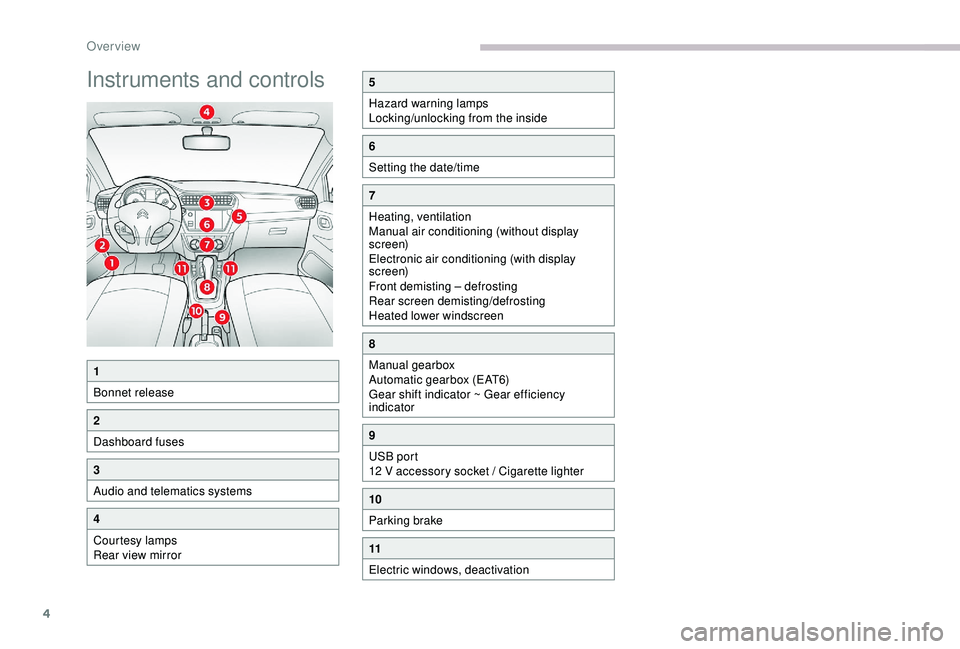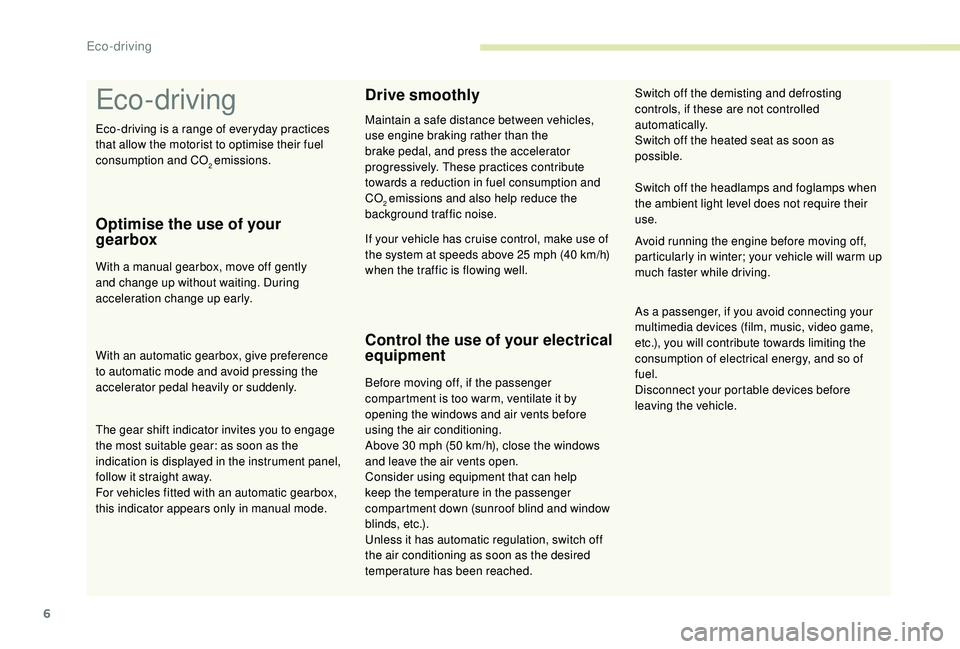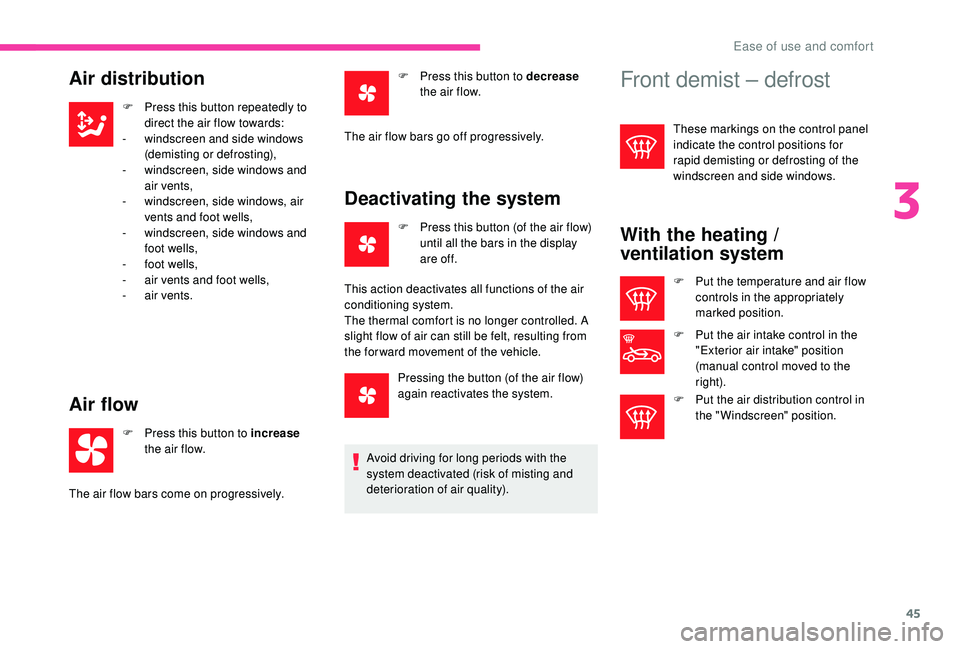air condition CITROEN C-ELYSÉE 2022 Handbook (in English)
[x] Cancel search | Manufacturer: CITROEN, Model Year: 2022, Model line: C-ELYSÉE, Model: CITROEN C-ELYSÉE 2022Pages: 260, PDF Size: 8.4 MB
Page 4 of 260

2
.
.
Instrument Panel 8
W arning and indicator lamps 9
I
ndicators
19
Distance recorders
2
4
Setting the date and time
2
4
Trip computer
2
6Remote control
2
9
Alarm
32
Doors
33
Boot
34
Window controls
3
6
Front seats 3 7
Rear bench seat 3 9
Steering wheel adjustment 4
0
Mirrors
4
0
Heating
4
1
Manual air conditioning
(without display screen)
4
2
Electronic air conditioning
(with display screen)
4
4
Front demist – defrost
4
5
Rear screen demist – defrost
4
6
Fittings
4
8Lighting control
5
1
Direction indicators
5
3
Headlamp adjustment
5
4
Wiper control stalk
5
4
Courtesy lamps
5
5
General safety recommendations
5
7
Hazard warning lamps
5
8
Horn 58
Emergency or assistance call 5 8
Electronic stability control (ESC)
6
0
Seat belts
6
2
Airbags
65
Child seats
6
8
Deactivating the passenger's front airbag
7
0
ISOFIX mountings
7
5
Child lock
7
9
Over view
Instruments Access
Ease of use and comfort Safety
Lighting and visibility
Eco-driving
Eco-driving 6
Contents
Page 6 of 260

4
Instruments and controls5
Hazard warning lamps
Locking/unlocking from the inside
6
Setting the date/time
7
Heating, ventilation
Manual air conditioning (without display
screen)
Electronic air conditioning (with display
screen)
Front demisting – defrosting
Rear screen demisting/defrosting
Heated lower windscreen
8
Manual gearbox
Automatic gearbox (EAT6)
Gear shift indicator ~ Gear efficiency
indicator
9
USB port
12 V accessory socket / Cigarette lighter
10
Parking brake
11
Electric windows, deactivation
1
Bonnet release
2
Dashboard fuses
3
Audio and telematics systems
4
Courtesy lamps
Rear view mirror
Over view
Page 8 of 260

6
Eco- driving
Optimise the use of your
gearbox
With a manual gearbox, move off gently
and change up without waiting. During
acceleration change up early.
With an automatic gearbox, give preference
to automatic mode and avoid pressing the
accelerator pedal heavily or suddenly.
Drive smoothly
Maintain a safe distance between vehicles,
use engine braking rather than the
brake pedal, and press the accelerator
progressively. These practices contribute
towards a reduction in fuel consumption and
CO
2 emissions and also help reduce the
background traffic noise.
Control the use of your electrical
equipment
Before moving off, if the passenger
compartment is too warm, ventilate it by
opening the windows and air vents before
using the air conditioning.
Above 30
mph (50 km/h), close the windows
and leave the air vents open.
Consider using equipment that can help
keep the temperature in the passenger
compartment down (sunroof blind and window
blinds, etc.).
Unless it has automatic regulation, switch off
the air conditioning as soon as the desired
temperature has been reached. Switch off the headlamps and foglamps when
the ambient light level does not require their
use.
Avoid running the engine before moving off,
particularly in winter; your vehicle will warm up
much faster while driving.
As a passenger, if you avoid connecting your
multimedia devices (film, music, video game,
etc.), you will contribute towards limiting the
consumption of electrical energy, and so of
fuel.
Disconnect your portable devices before
leaving the vehicle.
The gear shift indicator invites you to engage
the most suitable gear: as soon as the
indication is displayed in the instrument panel,
follow it straight away.
For vehicles fitted with an automatic gearbox,
this indicator appears only in manual mode. If your vehicle has cruise control, make use of
the system at speeds above 25
mph (40 km/h)
when the traffic is flowing well. Switch off the demisting and defrosting
controls, if these are not controlled
automatically.
Switch off the heated seat as soon as
possible.
Eco-driving is a range of everyday practices
that allow the motorist to optimise their fuel
consumption and CO
2 emissions.
Eco-driving
Page 44 of 260

42
Deactivation
If you put the air flow control in the 0 position,
t he temperature is no longer controlled.
A slight flow of air can still be felt, resulting from
the for ward movement of the vehicle.
Air distribution
Windscreen and side windows.
Windscreen, side windows and
footwells.
Footwells.
Centre and side air vents,
footwells.
Central and side vents.
The air distribution can be adapted
by placing the thumb wheel in an
intermediate position or by closing
the vents.
Air intake / Air recirculation
Recirculation of the interior air isolates the
passenger compartment from exterior odours
and fumes.
Return to exterior air intake as soon as possible
to avoid deterioration of the air quality and the
formation of mist.
F
M
ove the manual control to the
left for the "Recirculation of
interior air" position.
F
M
ove the manual control to the
right to return to the "Exterior air
intake" position.
Manual air conditioning
(without display screen)
This system operates only with the engine
running.
1 Temperature.
2 A ir f low.
3 Air distribution.
4 Air intake / Air recirculation.
5 Air conditioning.
Temperature
F Turn the thumb wheel from
blue (cold) to red (hot) to adjust
the temperature to your liking.
Air flow
F Turn the thumb wheel to obtain a comfortable air flow.
Ease of use and comfort
Page 45 of 260

43
Deactivation
If you put the air flow control in the 0 position,
t he temperature is no longer controlled.
A slight flow of air can still be felt, resulting from
the for ward movement of the vehicle.
Air distribution
Windscreen and side windows.
Windscreen, side windows and
footwells.
Footwells.
Centre and side air vents,
footwells.
Central and side vents.
The air distribution can be adapted
by placing the thumb wheel in an
intermediate position or by closing
the vents.
Air intake / Air recirculation
Recirculation of the interior air isolates the
passenger compartment from exterior odours
and fumes.
Return to exterior air intake as soon as possible
to avoid deterioration of the air quality and the
formation of mist.
F
M
ove the manual control to the
left for the "Recirculation of
interior air" position.
F
M
ove the manual control to the
right to return to the "Exterior air
intake" position.
Air conditioning
The air conditioning is designed to operate
efficiently in all seasons, with the windows
closed.
It allows you:
-
i
n summer, to lower the temperature,
-
i
n winter, to increase the effectiveness of
the demisting, above 3°C.
Switching on
F Press this button, its indicator lamp comes on.
The air conditioning does not operate
when the air flow adjustment control is in
position "0".
Faster cool air
To obtain cool air more quickly, you can
use recirculation of the interior air for a few
moments. F
M
ove the manual control to the
left for the "Recirculation of
interior air" position.
F
T
hen, move the manual control
to the right to return to the
"Exterior air intake" position.
Switching off
F Press this button again, its indicator lamp goes off.
Switching the system off could result in
discomfort (humidity, condensation).
3
Ease of use and comfort
Page 46 of 260

44
Electronic air conditioning
(with display screen)
This system operates only with the engine
running.
1Air intake / Air recirculation.
2 Temperature.
3 Air conditioning.
4 Faster air conditioning.
5 Air distribution.
6 A ir f low.
Air intake/air recirculation
The recirculation of interior air isolates the
passenger compartment from exterior odours
and smoke.
Avoid prolonged use of interior air
recirculation (risk of misting and
deterioration of air quality). F
P
ress the button to prevent
fresh air from entering and
recirculate the interior air. The
indicator lamp illuminates in the
display screen to confirm this.
F
P
ress the button again to allow
fresh air to enter. The indicator
lamp goes off in the display
screen to confirm this.
Temperature
F Press these buttons (red for hot and blue for cold), to
adjust the temperature to your
requirements.
The temperature bars come on or go off
progressively on the display.
Air conditioning
Switching on
F Press this button, its indicator lamp appears on the display.
Switching off
F Press this button again, the indicator lamp goes off.
Switching the system off could result in
discomfort (humidity, condensation).
Faster air conditioning
This button activates rapid cooling of the air in
the passenger compartment.
Switching on
F Press this button, its indicator lamp appears in the display.
Switching off
F Press this button again, its indicator lamp goes off.
Ease of use and comfort
Page 47 of 260

45
Air distribution
F Press this button repeatedly to direct the air flow towards:
-
w
indscreen and side windows
(demisting or defrosting),
-
w
indscreen, side windows and
air vents,
-
w
indscreen, side windows, air
vents and foot wells,
-
w
indscreen, side windows and
foot wells,
-
f
oot wells,
-
a
ir vents and foot wells,
-
a
ir vents.
Air flow
F Press this button to increase
the air flow.
Deactivating the system
F Press this button (of the air flow) until all the bars in the display
are of f.
F
P
ress this button to decrease
the air flow.
The air flow bars come on progressively. The air flow bars go off progressively.
This action deactivates all functions of the air
conditioning system.
The thermal comfort is no longer controlled. A
slight flow of air can still be felt, resulting from
the for ward movement of the vehicle.
Pressing the button (of the air flow)
again reactivates the system.
Avoid driving for long periods with the
system deactivated (risk of misting and
deterioration of air quality).
Front demist – defrost
These markings on the control panel
indicate the control positions for
rapid demisting or defrosting of the
windscreen and side windows.
With the heating /
ventilation system
F Put the temperature and air flow controls in the appropriately
marked position.
F
P
ut the air intake control in the
"Exterior air intake" position
(manual control moved to the
right).
F
P
ut the air distribution control in
the "Windscreen" position.
3
Ease of use and comfort
Page 48 of 260

46
With the manual air
conditioning system
(without screen)
F Put the temperature and air flow controls in the appropriately
marked position.
F
P
ut the air intake control in the
"Exterior air intake" position
(manual control moved to the
right).
F
P
ut the air distribution control in
the "Windscreen" position.
F
S
witch on the air conditioning by
pressing the appropriate button;
the lighting of the associated
control comes on.
With the electronic air
conditioning system (with
screen)
F Press this button.
The button indicator lamp comes on.
F
P
ress this button again to switch
it of f.
The button indicator lamp goes off.
Heated lower windscreenRear screen demist –
defrost
Switching on
Demisting – defrosting of the rear screen can
only function when the engine is running.
Switching off
Defrosting switches off automatically to prevent
excessive electrical consumption.
F
T
he front defrosting operation
can be stopped before it turns
off automatically by pressing the
button again.
The indicator lamp associated with the button
goes off.
The function is active when the exterior
temperature is below 0°C.
(Depending on the country of sale.)
F
P
ress this button to demist /
defrost the rear screen and
(depending on version) the
door mirrors. The indicator
lamp associated with the button
comes on.
In cold conditions, the heated rear screen
switch also allows the lower windscreen to be
heated, so as to free the wiper blades when
frozen to the glass by frost or snow.
Ease of use and comfort
Page 49 of 260

47
Turn off the defrosting of the rear
screen and side mirrors (depending on
the version) as soon as you consider it
necessary.
Because lower energy consumption
reduces fuel consumption.Advice
In order for these systems to be fully
effective, follow the operation and
maintenance guidelines below:
F
T
o ensure that the air is distributed
evenly, keep the external air intake
grilles at the base of the windscreen, the
nozzles, the vents, the air outlets and the
air extractor located in the back free from
obstructions.
F
O
perate the air conditioning system for
at least 5
to 10 minutes, once or twice a
month to keep it in per fect working order.
F
T
o prevent misting or deteriorating
air quality inside the passenger
compartment, you should not deactivate
the system for too long and avoid
extended operation of the air recirculation
system when driving.
F
E
nsure that the passenger compartment
filter is in good condition and have the
filter elements replaced regularly.
We recommend the use of a combined
passenger compartment filter. Thanks to
its special active additive, it contributes
to the purification of the air breathed by
the occupants and the cleanliness of the
passenger compartment (reduction of
allergic symptoms, bad odours and greasy
deposits). F
T o ensure correct operation of the air
conditioning system, you are also advised
to have it checked regularly according
to the Maintenance and Warranty Guide
recommendations.
F
I
f the system does not produce cold air,
switch it off and contact a CITROËN
dealer or a qualified workshop.
When towing the maximum load on a steep
gradient in high temperatures, switching off
the air conditioning increases the available
engine power and so improves the towing
ability.
3
Ease of use and comfort
Page 50 of 260

48
Fittings
Glove box
It can be used to hold a water bottle, the
vehicle's handbook pack, etc.
Depending on version, it may have a lid. In this
case:
F
T
o open the glove box, raise the handle.
Removable ashtray
F Raise the cover to open the ashtray.
F T o empty it, with the cover raised, pull the
ashtray upward.
It contains the front passenger airbag
deactivation switch.
To avoid any problem of inter ference
or risk of overturning, do not place the
ashtray near the gear lever.
Sun visor
Provides protection against sunlight from the
front or the side.
The passenger's sun visor is fitted with a vanity
mirror with concealing flap and a ticket holder.
If after a long period parked in the
sun, the interior temperature is very
high, first ventilate the passenger
compartment for a few moments.
Put the air flow control at a setting high
enough to quickly change the air in the
passenger compartment.
The air conditioning system does not
contain chlorine and does not present
any danger to the ozone layer.
Stop & Star t
The heating and air conditioning systems
only work when the engine is running.
To maintain a comfortable temperature
in the passenger compartment, you can
temporarily deactivate the Stop & Start
system.
For more information on Stop & Star t ,
refer to the corresponding section.
Ease of use and comfort